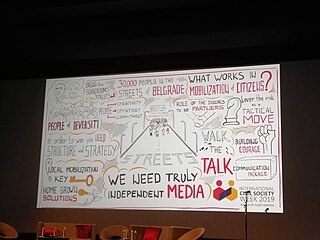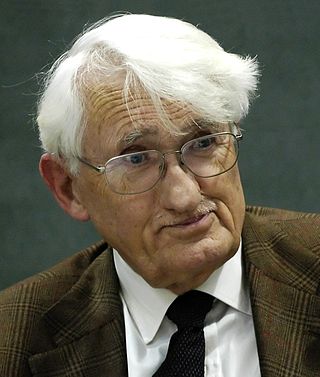
Jürgen Habermas is a German philosopher and social theorist in the tradition of critical theory and pragmatism. His work addresses communicative rationality and the public sphere.

Civil society can be understood as the "third sector" of society, distinct from government and business, and including the family and the private sphere. By other authors, civil society is used in the sense of 1) the aggregate of non-governmental organizations and institutions that advance the interests and will of citizens or 2) individuals and organizations in a society which are independent of the government.

California State University, Chico is a public university in Chico, California. It was founded in 1887 as one of about 180 "normal schools" founded by state governments in the 19th century to train teachers for the rapidly growing public common schools. Some closed but most steadily expanded their role and became state colleges in the early 20th century and state universities in the late 20th century. It is the second oldest campus in the California State University system. As of the fall 2020 semester, the university had a total enrollment of 16,630 students. The university offers 126 bachelor's degree programs, 35 master's degree programs, and four types of teaching credentials. Chico is a Hispanic-serving institution (HSI).

The public sphere is an area in social life where individuals can come together to freely discuss and identify societal problems, and through that discussion influence political action. A "Public" is "of or concerning the people as a whole." Such a discussion is called public debate and is defined as the expression of views on matters that are of concern to the public—often, but not always, with opposing or diverging views being expressed by participants in the discussion. Public debate takes place mostly through the mass media, but also at meetings or through social media, academic publications and government policy documents.

Citizen participation or public participation in social science refers to different mechanisms for the public to express opinions—and ideally exert influence—regarding political, economic, management or other social decisions. Participatory decision-making can take place along any realm of human social activity, including economic, political, management, cultural or familial.

E-democracy, also known as digital democracy or Internet democracy, uses information and communication technology (ICT) in political and governance processes. The term is credited to digital activist Steven Clift. By using 21st-century ICT, e-democracy seeks to enhance democracy, including aspects like civic technology and E-government. Proponents argue that by promoting transparency in decision-making processes, e-democracy can empower all citizens to observe and understand the proceedings. Also, if they possess overlooked data, perspectives, or opinions, they can contribute meaningfully. This contribution extends beyond mere informal disconnected debate; it facilitates citizen engagement in the proposal, development, and actual creation of a country's laws. In this way, e-democracy has the potential to incorporate crowdsourced analysis more directly into the policy-making process.
Incivility is a general term for social behaviour lacking in civility or good manners, on a scale from rudeness or lack of respect for elders, to vandalism and hooliganism, through public drunkenness and threatening behaviour. The word "incivility" is derived from the Latin incivilis, meaning "not of a citizen".
Discourse ethics refers to a type of argument that attempts to establish normative or ethical truths by examining the presuppositions of discourse. The ethical theory originated with German philosophers Jürgen Habermas and Karl-Otto Apel, and variations have been used by Frank Van Dun and Habermas' student Hans-Hermann Hoppe.

Civic engagement or civic participation is any individual or group activity addressing issues of public concern. Civic engagement includes communities working together or individuals working alone in both political and non-political actions to protect public values or make a change in a community. The goal of civic engagement is to address public concerns and promote the quality of the community.
In political theory, refeudalization is the process of recovering the political mechanisms and relationships that used to define feudalism. Because the term "feudalism" is slightly ambiguous, "refeudalization" is ambiguous, too.

The Structural Transformation of the Public Sphere: An Inquiry into a Category of Bourgeois Society is a 1962 book by the philosopher Jürgen Habermas. It was translated into English in 1989 by Thomas Burger and Frederick Lawrence. An important contribution to modern understanding of democracy, it is notable for "transforming media studies into a hard-headed discipline." In 2022 Habermas published a brief sequel, A New Structural Transformation of the Public Sphere and Deliberative Politics.
In sociology, communicative action is cooperative action undertaken by individuals based upon mutual deliberation and argumentation. The term was developed by German philosopher-sociologist Jürgen Habermas in his work The Theory of Communicative Action.

Constitutional patriotism is the idea that people should form a political attachment to the norms and values of a pluralistic liberal democratic constitution rather than to a national culture or cosmopolitan society. It is associated with post-nationalist identity because, while it is seen as a similar concept to nationalism, the attachment is based on the constitution rather than on a national culture. In essence, it is an attempt to re-conceptualize group identity with a focus on the interpretation of citizenship as a loyalty that goes beyond individuals' ethnocultural identification. Theorists believe this to be more defensible than other forms of shared commitment in a diverse modern state with multiple languages and group identities. It is particularly relevant in post-national democratic states in which multiple cultural and ethnic groups coexist. It was influential in the development of the European Union and a key to Europeanism as a basis for multiple countries belonging to a supranational union.
Radical democracy is a type of democracy that advocates the radical extension of equality and liberty. Radical democracy is concerned with a radical extension of equality and freedom, following the idea that democracy is an unfinished, inclusive, continuous and reflexive process.
The salons of early modern France were social and intellectual gatherings that played an integral role in the cultural development of the country. The salons were seen by contemporary writers as a cultural hub for the upper middle class and aristocracy, responsible for the dissemination of good manners and sociability. Salons became a center of intellectual conversation, as well as a debate stage for social issues, playing host to many members of the Republic of Letters. In contrast to other early modern institutions, women played an important and visible role within the salons. Each woman, or salonnière, played a different role within these salons. Some were actively involved in conversation and debate, while others used their connections to bring others together and spread Enlightenment ideas.
The salons of Early Modern and Revolutionary France played an integral role in the cultural and intellectual development of France. The salons were seen by contemporary writers as a cultural hub, responsible for the dissemination of good manners and sociability. It was not merely manners that the salons supposedly spread but also ideas, as the salons became a centre of intellectual as well as social exchange, playing host to many members of the Republic of Letters. Women, in contrast to other Early Modern institutions, played an important and visible role within the salons. The extent of this role is, however, heavily contested by some historians.
Action civics is a modern and alternative form of civics education in the United States. Action civics is an applied civic education process in which participants learn about government by examining issues in their own community and then select a focus issue for action through a process of debate, research the issue and learn advocacy strategies, develop civic skills such as public speaking, formulate a plan, mobilize, educate, then evaluate, and reflect on their experience. Participants' voices are encouraged, valued and incorporated. Participants learn by doing, with a focus on collective action. Action civics can encompass a number of different actions from community service to electoral engagement and from talking about concerns with public officials to creating peer education campaigns.

Public rhetoric refers to discourse both within a group of people and between groups, often centering on the process by which individual or group discourse seeks membership in the larger public discourse. Public rhetoric can also involve rhetoric being used within the general populace to foster social change and encourage agency on behalf of the participants of public rhetoric. The collective discourse between rhetoricians and the general populace is one representation of public rhetoric. A new discussion within the field of public rhetoric is digital space because the growing digital realm complicates the idea of private and public, as well as previously concrete definitions of discourse. Furthermore, scholars of public rhetoric often employ the language of tourism to examine how identity is negotiated between individuals and groups and how this negotiation impacts individuals and groups on a variety of levels, ranging from the local to the global.
In this article Jürgen Habermas, Sara Lennox, and Frank Lennox attempt to examine the notions of Habermas's thesis, The Structural Transformation of the Public Sphere focusing on the development of the public sphere today. The article begins by demonstrating the idea of a public sphere, referring to it as a “concept” in which private individuals assemble to form a public body in an “unrestricted fashion”. According to Habermas, the public sphere itself is to derive from democracy. He highlights the importance of the freedom to assemble and to express opinions in an inclusive manner. The opinions on matters of general interest from a large public body require a vehicle of transmission in order to supply information and enable the possibility for societal influence. He determines that the modern means for this transmission are through media such as newspapers, magazines, television, and radio.
The European public sphere refers to the public sphere where ideas and information are exchanged by citizens of European societies that can influence the European political life. It is to have an "arena for EU-wide public discourse".










